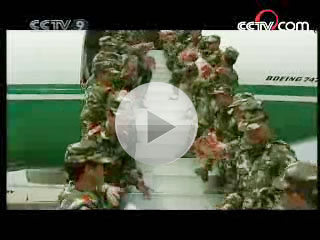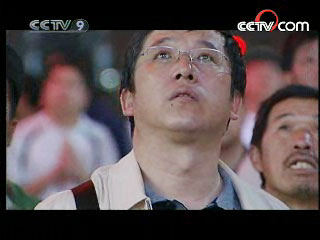------Program code: DO-080620-02164 (what's this?)
Source: CCTV.com
06-20-2008 10:03
Special Report: Documentary: The EarthquakeOn May 12, 2008, a magnitude -8 earthquake hit Wenchuan County in Sichuan Province, China.
 |
This is what happened in the Sushan Primary School, in Beichuan County 30 minutes after the earthquake. As the picture shows, the rescue operation in the affected area began as soon as the shaking stopped.
This image, taken in Wenchuan County only 10 minutes after the quake hit, tells us the same thing: in the wake of the disaster, people began to immediately help each other but while the crowd in the disaster area began to rescue themselves, they were still extremely anxious for help from the outside world. They soon realized, however, that all the roads leading to Wenchuan, the epicenter of the earthquake, were blocked and all communications with the outside world were cut.
 |
It took only minutes for many places, including Wenchuan, Beichuan and Mao County, to become completely isolated from the rest of the world but while the people in these affected areas were struggling to mount their own rescue operation, a nation-wide emergency rescue effort was being coordinated in an incredibly short space of time. Troops from all over the country were mustered and had one common target: to reach the north of Sichuan Province where the heaviest damage had occurred.
All the roads leading to the disaster areas were blocked, especially the road from Chengdu to northern Sichuan via Dujiangyan which was completely cut.
The People’s Liberation Army, the armed police, medical teams and rescue teams from Civil Affairs were gathering from all directions, but all these rescue forces were stuck in Dujiangyan, a city 50 kilometers from the center of the earthquake.
Songpan, National Highway 213, Beichuan, Inter-Province highway 302, Mao County, National Highway 317, Wenchuan, Li County, National Highway 213, Dujiangyan is the nearest county in Chendu to the center of the earthquake, and it is essential to pass through here on the way to Wenchuan. Rescue troops from Chengdu, the capital of Sichuan Province, had to take national highway 213 through Dujiangyan to get to the major disaster area. It was the most important route for channeling transport rescue forces and provisions to those who were urgently in need of help but because the roads to the disaster zone in northern Sichuan are far from the cities, it was extremely hard at first to gather rescue forces and provisions. What’s more, the earthquake left many other roads completely destroyed in its wake. The road from Dujiangyan to Wenchuan, for instance, was left with 9 sections which had totally collapsed and on top of this, there were frequent aftershocks and huge rocks were continuing to roll down the mountains and block the road even further. The first three kilometers of the road heading toward Wenchuan were covered by rocks and a further eight kilometers along, the road was completely blocked which meant that the rescue forces were stuck outside and the earthquake victims were trapped and isolated inside. Every second that passed further imperiled the lives of those buried in the ruins and the only first aid on hand was delivered by the survivors themselves.
The earthquake devastated Xiang’e, a town 15 kilometers from Dujiangyan City. 95% of the houses collapsed, and nearly 1000 people were buried in the ruins. The local governmental building collapsed and left more than ten governmental staff buried underneath the rubble. Despite this and due to the fact that the rescue forces from the outside world were unable to gain immediate access, the twenty surviving government officials made a decision : instead of staying and trying to rescue their friends and colleagues, they would head immediately to the local school a few hundred metres away where more than 400 hundred students were buried beneath the ruins of the school building.
Survivors were making an enormous effort to rescue the huge number of people buried and suffering in the ruins but they knew that the longer it took for rescue forces to arrive from the outside world, the more dangerous it became by the minute for the victims who were still trapped. For the rescue crews trying to get in from the outside, their main priority was to establish a lifeline to the cut-off towns at any cost. Because the roads were unfit for driving, the advanced troops of the PLA rescue forces quickly adopted the forced march method and their efforts were backed up by the air force who scrambled four military helicopters from the Chengdu Military Area to fly over Wenchuan and investigate just 21 minutes after the quake hit. But their efforts were to be hampered as well – heavy storms and cloud made landing impossible and despite repeated attempts, they failed to touch down and were forced to return to base. The Air Force then sent out a Special Forces parachute company but they too were prevented from landing by the bad weather.
